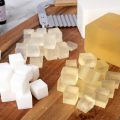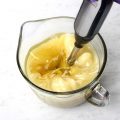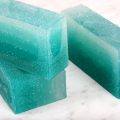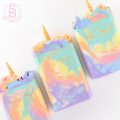If you’ve been soaping for a while, you’ve probably heard the term ‘INS Number’ and if you’re like many soapers, you scratch your head, research it a bit and then keep soaping your favorite recipe. An INS number refers to a numerical value that explains or describes the properties an oil will have when reacted with sodium hydroxide to make bar soap. It relates to the degree of unsaturation and molecular weight of the oil. Full disclosure: I don’t use INS numbers. I don’t find that they relate well to a finished batch of soap and how it will be perceived by me (or anyone) in the shower. The Bramble Berry lye calculator does not include INS numbers either. That said, some soapers swear by INS numbers though so like many soaping issues (example: to gel or not to gel?) using INS numbers is a personal preference.

INS is a soap theory that was developed in the 1930’s. It stands for … well, no one knows. It’s possible Iodine In Soap. Or possibly, Iodine And Saponification. But the theory hasn’t been deeply explored since the 1930’s and since then, in only one book, Dr. Robert McDaniels “Essentially Soap” (out of print but you can find it used).
An INS number is supposed to tell at a glance what an oil will do in soap in terms of hardness, conditioning, lather, iodine, cleansing. That’s like the holy grail of soapmaking -there would be no more thinking about how to design the best recipe for conditioning ability that also lathers well. Alas, it’s akin to using training wheels on a bike. It’s biking. It’s fun. But, you’re limited. In this case, the numbers are only guidelines.
Soap recipes turn out differently depending on where you are soaping. The actual bars of soap change depending on where you are showering (no joke; use the same bar of soap in a hard water versus soft water environment and there is a world of difference). Soaps lather differently depending on the temperature of the water. INS numbers will not fix the variations that all oils have from crop to crop. Depending on where an oil is grown, how it is harvested and how the climate changed from one batch to the next, the oil properties will be slightly different (really, truly!).
Supposedly, the ideal INS soap is to design a recipe that comes to the perfect 160 number. In this theory, a soap mixture with 160 INS will be a perfect bar of soap. Let’s look at this from a practical standpoint. If you had a soap with 100% Cocoa Butter, it would have almost a perfect INS number but it certainly would not be a perfect batch of soap. To test this theory, I actually made a batch of 100% Cocoa Butter soap (5% superfat, no water discount). It is truly a disgusting bar of soap – slimy, no lather, and a horrible feel when rinsed off.
I don’t believe that INS numbers can accurately predict if a bar is going to be “good” or not. What’s good for you is different than what I define as “good”. In my opinion, best case scenario, what INS numbers appear to predict is from a scientific standpoint is what technically should make a good bar of soap. Unfortunately, reality seems to override this perfect, sterile scientific theory. The most that INS values seem to predict, in my opinion, is how quickly and easily a batch will trace. Having a recipe that has an INS of 160 versus an INS of 110 gives you a faster trace and a harder (initially) bar of soap. Of course, if you want a hard bar of soap faster, water discounting will do that as well.
Using INS numbers is a personal preference. If you’re using them and love them, keep using them. They don’t hurt anything. But, if you’ve run your favorite recipe through an INS calculator and are feeling sad that your beloved recipe didn’t “score” very well, toss the calculator and don’t think about it again.
If you’d like a comprehensive list of INS numbers, Dr. Robert McDaniels has written a book about it (out of print but available used here) or you can download a spreadsheet with all the INS values for all oils listed here (it’s on the first tab). If you’d like to see how INS values are calculated, this blog post is comprehensive and informative.
And as for me and my soaping, my training wheels are off and I soap with all kinds of fun, exotic recipes, many of which break soaping rules. Join me! It’s fun.





I love what you have to say Anne-Marie and totally agree. The INS is kind of abstract and doesn’t reflect reality all the time. I use it- but I don’t hold it as complete truth- I use it as a fun guide.
Most importantly as soap makers, we have to use good judgment: we must use the soap we make, and feel it with all of our senses- Is it what we are looking for in a soap? Compare it to other soaps you have made. I look for a silky and creamy soap that cleans and lathers well. A soap maker must be very sensitive to detect the subtleties in their soap as well as ther soaps made by other soap makers. If the soap you make is good and you like it, but the INS numbers don’t score high, then go with your intuition and creativity- not the numbers.
Hi Frank!
I’m glad you liked this post, and thanks so much for sharing your expertise!
-Kelsey with Bramble Berry
As a newbie approximately 8 months into my new hobby and favorite thing to do. I tried, the tried & true’s and some no a lot of experimenting to my good fortune and many blessings I’d had knock them out of the Park right out of the gate 🙂 with family and friends wanting to purchase them. Now my attempt to be more professional 3 months ago racked my brain with INS#s an the 60:40 rule not only has not been that enjoyable but I’ve actually had to experience mistakes or issues like orange spots & ash. Now when I’m soaping I just use it as a guideline, however I cannot resist the cleansing and conditioning numbers I guess that’s just the newbie in me!
Hi Norma,
Congrats first and for most on your new hobby!
I find that trial and error sometimes make the most beautiful things.
Thank you so much for your comment and so glad that things are working out so well for you. If using the INS as a guideline helps you out, then stick with it. 🙂
Thanks again and happy soaping.
~Kevin with Bramble Berry
Great article!
I pay attention to INS but don’t get hysterical over it. The calculator I use is very detailed and displays your recipe’s INS so I do review it, but I think it is way to confusing for beginning soap makers to even worry about. They have enough to learn!
Once in a while I throw caution to the wind and do a soap that would make INS die-hards want to stuff some store-bought soap into my mouth, throw a BB Supplies box over my head and drop me into a vat of rancid olive oil! Haha. Results of such experiments usually wind up being perfectly ok.
Having said that, the calc I use gives your numbers in green if they are perfect and red out of range. Black numbers indicate acceptable and within range.
However, I am such a perfectionist that if all my numbers are green I want my INS to be as close to 160 as possible. Silly, I know. But that’s how I am. I think AM would understand completely!
Peace,
Scherry
AvieMare Body Care Products
http://www.facebook.com/aviemarebodycare
Hi Scherry,
That’s fantastic that INS numbers work for you! What calculator do you use? Feel free to share it, other soapers might want to take a look 🙂
-Kirsten
Hi Kristen. I just revisited this post. I think I know the answer to your question to Sherry. I believe the calculator she uses is an app for iPhones & iPads only, available through Apple iTunes. It’s called Soap Calc Pro. Check this out:
https://itunes.apple.com/us/app/soap-calc/id503494605?mt=8
And here’s a soaper using it:
https://www.youtube.com/watch?v=xRGK8LjQ2wM
The suggested characteristic ranges on the Soap Calc Pro appear to be the same as on Soap Calc.
I use Soap Calc only for adjusting the characteristics (Hardness, etc.) to reflect low numbers in all categories except Conditioning, in which I aim for a higher number….and I ignore the Iodine and INS numbers, which are always out of range when I do this. It used to drive me crazy. But my bars turn out fine – plenty hard, cleansing, bubbly and creamy enough. I have hard water and dry weather, so this works really well for me.
I recently just revisited the INS theory and ran a number of my recipes through. I made a few new batches and found that my soaps are more drying and I was feeling a bit dissapointed that I changed my favorite recipies and they didn’t pass the skin test with a better “cleansing” number. Not fun at all. I have switched back but I still am glad I gave it a go. I figure, you never know what’s gonna work unless you try and have fun while doing it. After all it good “clean” fun 🙂
What a great attitude to have! And you are absolutely correct, it never hurts to experiment and play around with soapmaking. 🙂
-Becky with Bramble Berry
Thank you, Anne-Marie, for your words on INS numbers. I’ve only been soaping for a couple of years, and my Best.Soap.Ever recipe fails the soap calc spreadsheets miserably. It’s inspiring to know that soap is so utterly personal, and that’s what transforms this craft into art. I will continue to experiment with different combos of oils without feeling like I’m not being a “good” soaper.
A tried and true recipe that you develop on your own is such a precious thing, and deserves the credit for the work that went into it, regardless of what the numbers say! 🙂 -Kristen with Bramble Berry
Jenny beat me to the point about Castile soap. I am super new to soaping, so I read a lot of soap discussions. Another new soaper dismissed Castile because it had a 0 for cleansing. I knew that wherever the other newbie got her information, it certainly wasn’t taking real life into account!
Thanks for explaining these numbers to me and for reminding me that theory and practice are often farther apart than we care to admit.
Thank you also for reminding me that although I am new, my real life experience counts for a lot. Off to make more lovely Castile!
I’m with you, no way would I disregard Castile soaps, I love them too much. 🙂 -Kristen with Bramble Berry
Thank you Anne-Marie! I don’t follow INS numbers but did look at them when I was researching how to make CP 5 years ago. I now feel a little more justified in my disregard… lol 🙂
You’re perfectly right and I completely agree with you.
Soap making in that order as we do as hobby (or not always hobby) should be accompanied by fun, personal talent and taste.
You can explain the theory with natural sciences but you can not explain and forecast the product. It’s more like cooking. Let 50 cooks do the same recipe from a single book with identical ingredients and you’ll have 50 different tastes.
It is the difference between gourmet restaurant and McDonald’s So keep making soaps with fun I’m sure the result is better than any SCIENTIFIC soap made by scientists.
That’s a great analogy! So true, love it. -Kristen with Bramble Berry
Thank you for this great post Anne-Marie.
Lately I’ve been giving, probably, too much attention to this “Cleaning” number in my Soap Calc. I was making olive oil baby soap and was shocked, how could it be that there is a zxero for cleansing?
Still, as a newbie at CP soaping besides following Soap Queen’s recipes, i try to search for “my own” recipe and for this reason I rely on soap calc a lot. Is it good or bad? And how should I know Soap Calc lies to me?
I relied on tried and true recipes when I was new and my soaping ego was too fragile to handle any batch mishaps. 🙂 In the end, it’s about what you like in a bar! Once you feel confident, experiment a little bit with ingredients and see if you like what you come up with! -Kristen with Bramble Berry
Thanks for the post Anne-Marie! I have researched everything I can for making soap. I’ve even read crazy things in published books ( like using crayons to dye soap, which made absolutely no sense along with some other weird findings) … I am joining you & throwing my training wheels away!! The INS was one that baffled me. Thanks for clearing things up!!!
Yeah! Get adventurous, have fun…you never know what you’ll come up with! 🙂 -Kristen with Bramble Berry
Thanks for the explanation 😀 Always learning something new from you!
Great post, Anne-Marie! I agree, sometimes the numbers you get from a soap calculator don’t always reflect how a soap will perform. Castile soap gets a zero for cleansing when you run it through SoapCalc, but it turns out to be a great bar of soap! It’s still fun to play with the numbers, though, to try to get an idea of what a soap might be like when formulating a recipe. By the way, I believe that the book “Soap Maker’s Workshop” by Dr. Robert S. and Katherine J. McDaniel is an updated version of “Essentially Soap.” 🙂
Thanks for the heads up on the book, I’ll let Anne-Marie know to check it out! 🙂 -Kristen with Bramble Berry